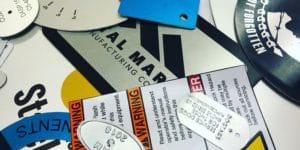There are a wide variety of nameplate processes available on the market. When you aren’t familiar with nameplates, it can be hard to know which process is right for your application. Each process is a little bit different and can also be dependent on the material of the metal nameplate. This quick guide will help get you started when you are looking to order the best metal nameplates.
1.) Embossing
Metal embossed nameplates feature raised characters which are pushed up from the back of the material. Embossed nameplates also offer excellent legibility even when they are painted over or dirty and our metal nameplates are often used by the mining industry.
Embossing provides the following benefits:
- Long lasting identification (20+ years)
- Outdoors, inclement weather, etc.
- Company name, address, phone number
- Serialization
2.) Stamping
Stamped nameplates include characters and numbers that are recessed into the material with deep impressions. They are great at remaining legible even when faced with tough conditions.
Stamping provides the following benefits:
- Long lasting identification
- Company name, logo, address and phone number
- Serialized and variable data
3.) MetalPhoto
MetalPhoto is a photosensitive anodized aluminum used when long-lasting identification is desired. This unique process seals an image inside of an anodic layer in the aluminum. In short, MetalPhoto is fully customizable. It also handles any design, text, logo, or image. In addition, it can be more cost-effective than other processes such as engraving.
MetalPhoto provides the following benefits:
- Resistance to corrosion, fading and abrasion
- Rated for 20+ years outdoors durability
- Features any image, design, or information
- Support for barcodes for easy scanning and tracking
4.) Screen Printing
Instead of using a stamp or die to embed information, screen printing applies durable ink on the surface of the metal nameplate. These nameplates have a stand-out look, and can be made with full color designs.
Screen printing provides the following benefits:
- Fully customizable – full color
- Company name, logo, address, phone number
- Serialization/Barcodes/Variable Data
5.) Etching
Etched nameplates use a unique indentation process of cutting into the metal nameplate’s surface using a special chemical or laser process. With the option for etch and fill, etched nameplates also feature color customization.
Etching provides the following benefits:
- Etch and fill process for color
- Company name, logo, address and phone number
- Wide variety of materials and thicknesses
6.) Engraving
Engraving uses a special machine to carve out the information or design into the metal material. This is a very time consuming process, and also expensive. However, engraving allows for total customization as every character is cut individually.
Engraving provides the following benefits:
- Fully customizable
- Company name, logo, address, phone number
- Serialization, Variable Information
Wrap-Up
In conclusion, there are many processes used to add information to nameplates. Consequently, each has its own set of pros and cons. Some are more durable, others are more customizable. If you still aren’t sure where to begin, your supplier can help point you in the right direction.
